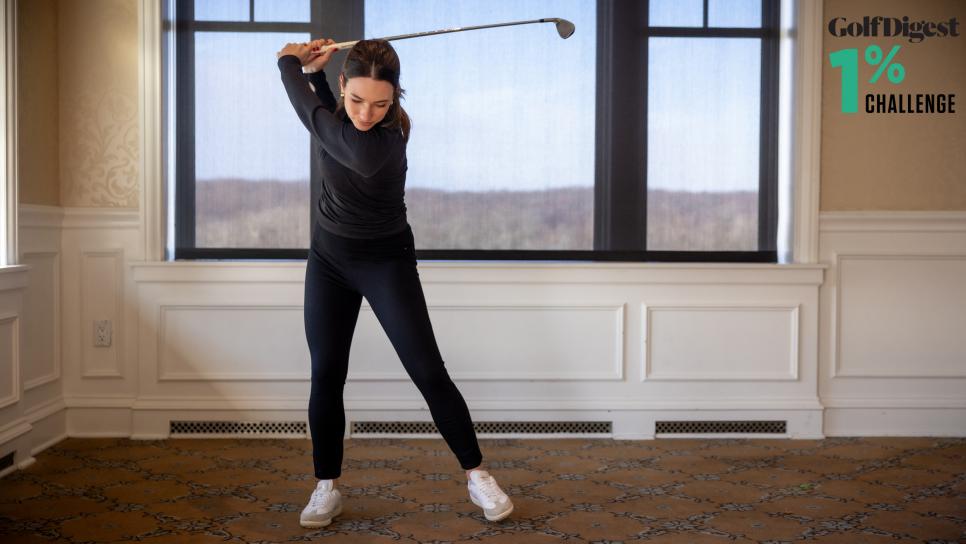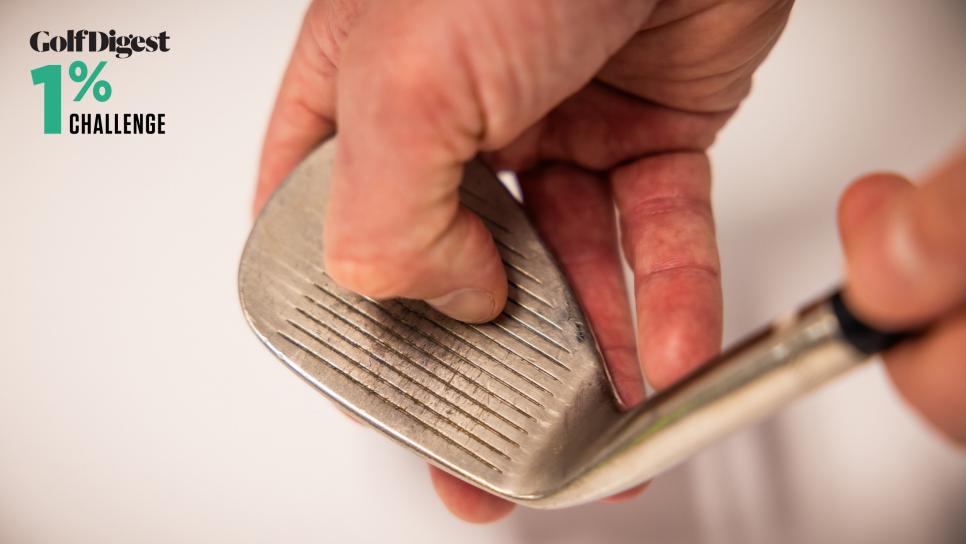New Year, New You
1 Percent Challenge: Upgrade your coffee routine to reduce jitters

Editor’s Note: The Golf Digest 1 Percent Challenge will present a new challenge every weekday in January. Catch up on Week 1, Week 2, and Week 3.
Many golfers are early risers. The problem, though, is after our morning coffee, we often rush to the first tee and are shaky because the caffeine hits a little too strong. Others get anxious before an important round, and caffeine only worsens the fight-or-flight feeling. Unfortunately, golf isn’t a sport where you can put excess anxious energy into “trying harder” to get better results. Instead, we need to calm ourselves as much as possible.
The Solution: You’re not willing to give up the caffeine, but if you mix in L-theanine, an amino acid found in tea, you’ll have less anxiety and jitters. L-theanine fights the jitters by increasing levels of calming neurotransmitters like serotonin. Studies have shown L-theanine relieves stress, improves mood and helps sleep. It has also been linked to improved cognitive performance.
Today: Reflect on your caffeine intake and how your body reacts after having it. Do you get anxious or jittery? Do you ever get shaky on the golf course because you had too much caffeine? How is the quality of your sleep? If you have any concerns with these, then order L-theanine to start adding to your coffee. If you don’t drink coffee but still want to try it out, you can take an L-theanine supplement.
And then … : Add L-theanine to your coffee or take an L-theanine supplement to still get the stress-relieving benefits. Use an L-theanine-to-caffeine ratio of 2:1. A typical cup of coffee has about 100 mg of caffeine, so mix in 200 mg of L-theanine. Recommended amounts of L-theanine are 200-400 mg a day.—Drew Powell
Day 19: Train your balance to find the center of the face

Earl Woods told a young Tiger to swing as hard as he could, under two conditions: He remained in balance and hit the middle of the face. Given modern analytics, we know that for most golfers, the quickest way to improve is to gain distance. While that has spurred golfers to chase speed, you need to maintain balance and hit the center of the face to reap the full benefits of more swing speed.
The Solution: Improving your balance and stability throughout the swing will help you find the center of the face more often. Sure, swinging in balance reflects good technique, but it also requires a lot of strength in your small muscles in your legs and core. These stabilizing muscles help you properly transfer your weight and stay in posture throughout the swing.
Today: Get into a golf posture and cross your arms, putting them on your shoulders. Put your left foot about two feet behind your right and lift your left heel up. Turn your shoulders as if you were making a backswing. Do this slowly, 5-10 times. Feel as if you are turning “into” your right hip. Now place your right foot behind your left and rotate your shoulders as if you were making a follow-through. Repeat for 5-10 reps. Not only will this train your balance, but it will give you a great feeling of turning around your right leg in the backswing and then your left leg in the downswing (for right-handers).
And then … : If you get into a good routine of training your balance, you can start upgrading the moves. If you’re able, completely lift your back foot off the ground, instead of lifting just the heel. Consider buying a Bosu ball or balance board to continue to work on your stability at home.—Drew Powell
More from Golf Digest
Day 18: A simple drill to learn how to sequence your swing

The Solution: There’s a simple way to improve your golf swing's sequence, and it’s by exaggerating the motion of transferring to your lead side by literally stepping in that direction. It’s an easy drill to do with and without a golf ball.
Today: Stand with your feet together and, holding a club, get into golf posture. As you begin your takeaway, take a small step with your right foot to your right. As the club reaches the top of your backswing, take a bigger step to your left with your left foot and swing though.
No two golf swings are the same on the surface, even for tour players. But look under the hood, and you’ll find that all the best swings have the same engine. Coaches call it your golf swing's sequence, which is the order different parts of your body fire for maximum power. First, your weight shifts over to your lead side. Then your body begins to rotate before, finally, your wrists uncock as your body propels up to the finish. Too often amateur golfers get their sequence all wrong: They rotate first, never shift, and uncock their wrists too soon. It's a common cause of over-the-top golf swings, which can drain your golf swing of power and consistency.
And then . . . : Start with daily air swings, but devote 5-10 balls during your range sessions to hitting actual balls with this move. The more of this drill the better! — Luke Kerr-Dineen
Day 17: How to know when you need new wedges

Wedges might be the least considered clubs of all, normally replaced only when the grooves on your old ones are well past their useful life. We get it. The number of loft, bounce and grind combinations can be mind-numbing. And what’s the use of testing wedges off a mat or with a range ball? Valid points, but to give the wedges short-shrift is a huge mistake. Fact is you miss greens all the time and you’re using your wedges more often than that supersonic driver you’re longing for. Here’s some thoughts to gnaw on to determine if you need new wedges.
The Solution: It’s not as simple as whether your grips are worn. Yes, that is part of it but you likely use your lob wedge more often than your gap wedge so wedges often wear differently. You also need to know what wedges should be in your bag.
Today: Do a full accounting of your wedges and your wedge game. Do I have a wedge for pretty much every yardage I would need one for? Is the bounce and grind of your wedges ill-suited for your swing or the condition of your course (and if you don’t know what this means, this is where you can check)? Do your gap wedges have shafts similar to your irons (they should because they are full swing clubs more often than not). And yes, be aware of wear and tear. A good rule of thumb is this: If your wedge needs to be re-gripped, don’t. The grooves are probably already worn to a point of diminishing returns and you need a replacement more than a new grip.
And then . . . : Make changes. If you find you have a gap, determine which loft would fill that gap and take out a club you hardly use (and please don’t tell me you need that 4-iron to punch out from under trees). Learn about grinds and bounces. And, of course, we’re going to tell you to go see a fitter, but knowing you won’t, at least get educated before going to buy. Your scorecard will thank you. —E. Michael Johnson
Day 16: Dial in your impact position

The thing about golf swings is that they don’t actually matter. They’re a delivery system. A means to an end. The golf ball doesn’t know what your backswing looks like, or care how smooth your tempo is. The only thing the ball understands is how it was hit. This is the crucial transaction between clubface and ball that we know as the moment of impact. That is in some ways golf’s forgotten fundamental among the ranks of amateur golfers, and one that coaches are quick to remind them of. The more you improve your impact position, the easier your ball striking becomes.
The Solution: The first is a mindset shift. Challenge yourself to think about the golf swing from the impact position backwards. What do you want your moment of impact to be? And what’s your best way of getting there? Next, understand the keys of a good impact position: Hitting the ball with a descending blow with your irons, and on the upswing with your driver; having the clubface as square as possible to the target at impact; swinging within a few degrees of your target line (aka, swinging a little but not too much left or right); and with as much speed as you can muster.
Today: Take a beanbag, pillow, a pile of covers or anything else soft, and practice making full swings into it. Focus on impacting the club squarely into the back of the object, and remember how that feels.
And then…: Really, it’s about prioritizing a good impact position, and understanding what that means. I genuinely enjoyed this series by Micheal Breed about the “Facts of Impact,” which is worth a watch. Johnny Miller shared a good drill he used growing up, which involves swinging to a perpendicular line on the floor. If you have access to a simulator, keep in mind the clubface and swing path metrics. Negative means your swing or clubface are going to the left; positive means out to the right. Beware when one or both get too far away from zero.
More on the 1 Percent Challenge

Look, every golfer has big goals—30 more yards, 15 fewer pounds, tighter lines and better scores. We're not here to tell you those goals are out of reach. The problem with most New Year’s resolutions, though, is they start you at the foot of a mountain without a clear map to the top.
The Golf Digest 1 Percent Challenge, meanwhile, is meant to be both ambitious and achievable. None of the daily individual tasks will be so arduous that you'll need much time to cross them off your list. These are the type of modest improvements intended to make you just 1 better percent than you were the day before. But they’re also meant to provide you with a new skill that over time, can make a meaningful difference in your game.
The way it works is simple: Our team of expert editors in golf instruction, equipment and fitness have devised 23 challenges for each weekday in January that can be completed at home with minimal equipment. Things like checking your posture at address in the mirror, identifying yardage gaps in your club setup and testing the strength of your golf muscles. All of these challenges will have immediate value. But each challenge also comes with a suggested follow-up task that can lead to better habits, and ultimately, better performance.
It is the perfect way to get ready for the next golf season, even if you live somewhere where "real" golf is still months away. The more you follow along, the better your headstart on everyone else. —Sam Weinman